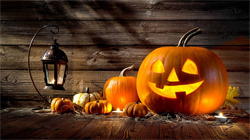
National Pumpkin Day in North America is celebrated annually on October 26. In the United States and Canada, one of the strongest associations with the fall season is pumpkin, because without bright orange pumpkins and dishes made from them, it is difficult to imagine both Halloween and Thanksgiving Day. Therefore, it is not surprising that National Pumpkin Day in North America is celebrated in the middle of autumn.
The birthplace of the pumpkin is considered to be the New World: the oldest pumpkin seeds, dating from the period from 7,000 to 5,000 BC, were found in Mexico. In the United States, pumpkin is one of the most popular and important crops.
Without a pumpkin, you cannot imagine one of the most popular American holidays - Halloween and Thanksgiving. A typical Halloween attribute is pumpkin – carved lamps with ominously grinning faces - Jack's lamps, and there should definitely be a pumpkin pie on the Thanksgiving table.
A couple of weeks before Halloween, Americans start going to pumpkin farms and bazaars to look for pumpkins for the holiday, and a little less than a week before Halloween, national Pumpkin Day is celebrated. This is a great opportunity to practice carving scary faces on pumpkins or cooking pumpkin pie with a new recipe.
Unlike decorative ones, edible varieties of pumpkin are used for food. Especially widely used even for children's and dietary nutrition. Pumpkin is used for salads and side dishes.
Undivided pumpkins are preserved for a long time, so they have long been used in farms. There are many old Russian dishes, including pumpkin.
In the XVII century, in the fairy tale "Cinderella" by Charles Perrault, the fairy made a carriage out of pumpkin as a product that is always in the kitchen, even the poorest.
In Central Asia, gourds (species of pumpkin) are used to make drinking vessels and cages for small songbirds.
Nazira Artykbayeva,
Librarian of the International Book Department

